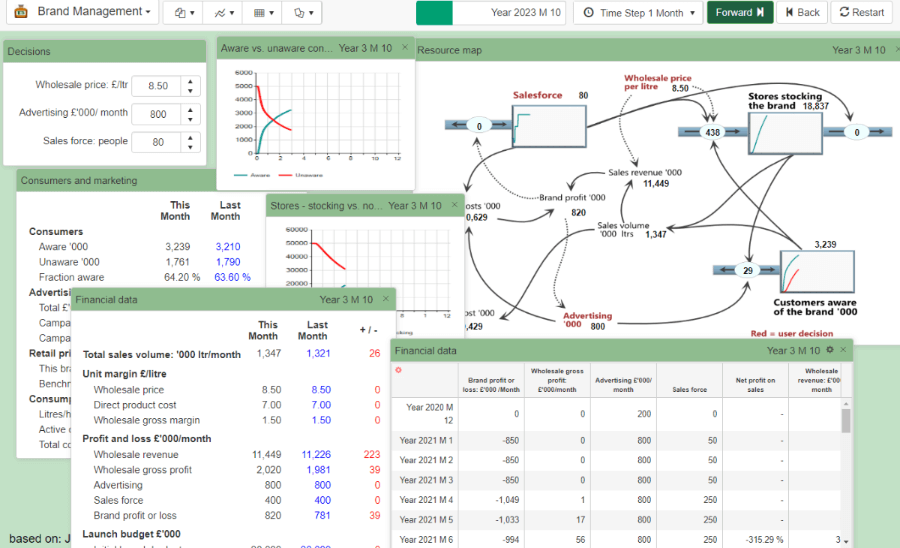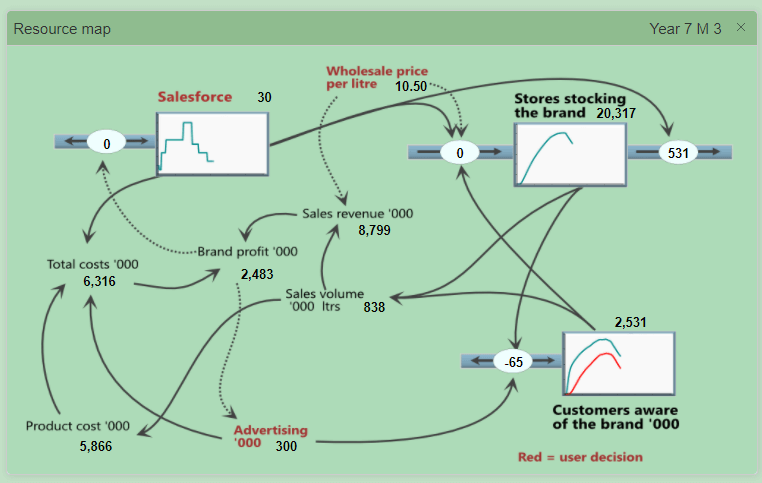Brand Management Challenge
Launch of a consumer brand
In this simulation, teams try to build and sustain sales and profitability for a high-value consumer brand, such as a premium coffee in a market with many potential consumers, who buy through retail stores. Success depends on:
- developing consumer interest by advertising, while not spending more than necessary to reach target consumers,
- growing distribution of the product through retail stores by deciding on the size of sales force – making sure not to employ more effort and cost than is worthwhile,
- setting a wholesale price that gives a good margin, whilst resulting in a retail price through stores that ensures consumers buy the product and still give stores a good profit.
Your team has been asked to market a premium brand and sell it through thousands of retail stores to capture demand from millions of potential consumers. Advertising spend wins consumer interest, but they will only buy the brand if it is in the stores, which needs a sales force. The brand must be profitable for those stores and for you, so pricing is a critical decision to determine profit margin and average consumer demand.
The brand competes in a broad market, rather than taking on specific competitors. Players can focus on marketing and sales issues, since production and distribution activities and costs are fixed.
In addition to launching a completely new brand with a limited budget, players can take over a business that has been spending on sales and advertising with little success, another that has grown quickly, or another that must be rescued from declining sales and profits.
Play Video
Video: Introduction to the game, with audio (8.5 mins)

Features
Initial conditions
Teams are the managers of a brand with a potential market of 5 million consumers and 50,000 stores. There is an initial budget within which they must accomplish the entire product launch.
Objectives
Grow the brand profitably in a large but finite market, making decisions that build consumers’ interest, extend product availability by ensuring that stores will benefit from sufficient demand and margin.
Setup
The simulation can be started with different levels of launch budget – the default value is generous, and players will discover there is a minimum level of total spending, below which no launch is possible.
The simulation runs over 12 years, with monthly decisions, although useful learning exercises may run over just a few simulated years. Decisions can be set to repeat over a number of periods automatically.
This is a relatively simple game with not too many 'moving parts', so it is quick to play. It is best to play in teams of 3-4 – one person responsible for each decision, plus maybe an overall brand manager.
| Feature List | |
|---|---|
| DECISIONS | Three decisions: Monthly advertising spend, Size of sales force and Wholesale price [retail stores add a fixed mark-up to determine the retail price to consumers] Teams choose when to run forward and the simulation runs forward one month with each step, or teams can choose to repeat decisions over several months. A 'Go back' option allows previous decisions to be revised an alternative strategies explored. |
| CHALLENGES | Three challenges included - part played scenarios that provide different situations for students to work with. The "Greedy" challenge is also supported by a spreadsheet / paper based exercise. |
| SAVE CHALLENGES | Teams can save the game at any point, to explore alternative strategies. |
| RESOURCE MAP | A ‘Resource Map’ of the brand architecture shows inter-relationships between 12 key measures. |
| REPORTS | Four numerical reports showing relevant financial and operational data. |
| CHARTS | Twenty pre-set charts showing the history of key data items. Additionally Any item appearing in a table can be represented as a chart - simply double click on the table heading. |
| TABLE DATA | Three tables showing entire history of financial and service data. |
| SAVE COMMENTS WITH GAMES | Can add comments to games either for display in games list or in a "Game Notepad". |
| TABLE OF USER DECISIONS | Makes it easy to keep track of your actions. |
| TABLE OF ALL PUBLIC VARIABLE | Analysis of game results is made easy with this additional feature. Results are presented in the same order as the reports / tables but can be exported in CSV format to enable straightforward analysis. |
| COPY TO OTHER APPLICATIONS | Use screen capture to obtain images of Reports or Graphs for copying into other applications for inclusion in documents and slide presentations produced. |
| TEACHERS MATERIALS | Event managers materials include the user’s guide as well as instructor’s slides and slide notes. |
Uses
This game can be played by individuals or small teams. It plays out business performance over a time-scale that is long enough to experience the complexity of strategy and decision-making. Teams control strategy by making a small number of key decisions, and can progress through the simulation at their own pace, trying alternatives and saving scenarios.
Event materials include the user's guide for students and, for instructor's, slides and slide notes.
The courses in which it may be useful are:
Strategy Dynamics - the business resource-system, interdependence between firm resources, managing functions in harmony (sales and advertising).
Strategy courses or workshops - basics of resource-based view (RBV): connection between resources and performance.
Systems thinking courses or workshops - resource-building and feedback (reinforcing)
Marketing courses or workshops - basics of developing both customers (through advertising) and channels (through sales force), working with limited marketing budgets.
The game offers good learning over 2-3 hours (including briefing and de-briefing), especially if teams have the opportunity to take on more than one challenge. But Brands can also be played in class on laptops with teams of two over just 30-40 minutes.
Brands makes a great ice-breaker for any undergraduate or MBA Marketing class or for executive education events in marketing or sales management.
Key learning points
The universal learning points the Brands Microworld shares with our other games include:
that any business system is a "machine" made up of factors – consumers and stores in this case – that work together to generate sales and profits
that strategy works through the decisions that build and sustain those resources
Specific issues that this game highlights include:
the co-dependency between end-customers and marketing channels – you need consumers to win stores and stores to win consumers
the diminishing returns to be gained from putting in ever-more effort (by the sales force) or spending (on advertising)
the risk that too little 'input' (that launch budget!) can destroy any chance of building a successful business.

Reviews
The University of Southern Maine used the Brand Management game with a group of high school students from Upward Bound, a non-profit organization that encourages disadvantaged youth to consider attending university once they graduate. John Voyer, who led the session, reported that "The activity ended up exceeding my expectations"
"We ended up with 18 high school students from all around Maine. They were part of a program called Upward Bound that's designed to get students more interested in going to college or university.
I have a colleague here who helped me out and who has lots of simulation experience. He was fascinated by the Brand Management Microworld, with which we played for 20 minutes or so before the students showed up. I also had a marketing colleague do this with me, to provide a marketing perspective.
Anyway, I spent about 15 minutes explaining how the simulation worked, including some discussion along the way of the stocks and flows. I wondered if the students would get it, but they did, and we let them run the microworld for about 35 minutes. I used Kim's standard approach of having them set objectives and decided ahead of time on a strategy (at least to start with). After about 10 minutes or so the nine groups of two had sorted themselves into groups that "got it" and were very successful, groups that didn't get it and struggled all the way through, and some groups in the middle. I'd say that by the end, 6 or 7 of the 9 groups had achieved a modicum of success or better.
I thought, and my colleagues agreed, that Brand Management was perfect for the activity with which we were faced. It had enough complexity to be challenging, yet not so much that the students were overwhelmed. My marketing colleague was impressed by how realistic the microworld was from a marketing standpoint.
The students themselves were very much engaged in it. Several called it "awesome." All said that the experience was totally different from anything they had ever done in high school. They left the room excited and energized. My colleagues and I felt the same way. We would do this exact same exercise again in a heartbeat. It was perfect for the task.
Thanks again for letting us use it. Installation and everything else technical went without a glitch."

Can you build and sustain a successful consumer brand and make it profitable before the launch budget runs out? How much profit can you make without destroying the very things that made it succeed in the first place?
Build a new brand or take on a business that a previous team has been managing…
Play a demo
Teachers can request access to full game and inspection documentation for evaluation